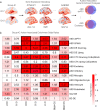Imbalanced social-communicative and restricted repetitive behavior subtypes of autism spectrum disorder exhibit different neural circuitry
- PMID: 33990680
- PMCID: PMC8121854
- DOI: 10.1038/s42003-021-02015-2
Imbalanced social-communicative and restricted repetitive behavior subtypes of autism spectrum disorder exhibit different neural circuitry
Abstract
Social-communication (SC) and restricted repetitive behaviors (RRB) are autism diagnostic symptom domains. SC and RRB severity can markedly differ within and between individuals and may be underpinned by different neural circuitry and genetic mechanisms. Modeling SC-RRB balance could help identify how neural circuitry and genetic mechanisms map onto such phenotypic heterogeneity. Here, we developed a phenotypic stratification model that makes highly accurate (97-99%) out-of-sample SC = RRB, SC > RRB, and RRB > SC subtype predictions. Applying this model to resting state fMRI data from the EU-AIMS LEAP dataset (n = 509), we find that while the phenotypic subtypes share many commonalities in terms of intrinsic functional connectivity, they also show replicable differences within some networks compared to a typically-developing group (TD). Specifically, the somatomotor network is hypoconnected with perisylvian circuitry in SC > RRB and visual association circuitry in SC = RRB. The SC = RRB subtype show hyperconnectivity between medial motor and anterior salience circuitry. Genes that are highly expressed within these networks show a differential enrichment pattern with known autism-associated genes, indicating that such circuits are affected by differing autism-associated genomic mechanisms. These results suggest that SC-RRB imbalance subtypes share many commonalities, but also express subtle differences in functional neural circuitry and the genomic underpinnings behind such circuitry.
Conflict of interest statement
JKB has been a consultant to, advisory board member of, and a speaker for Janssen Cilag BV, Eli Lilly, Shire, Lundbeck, Roche, and Servier. He is not an employee of any of these companies and not a stock shareholder of any of these companies. He has no other financial or material support, including expert testimony, patents, or royalties. CFB is director and shareholder in SBGneuro Ltd. SB discloses that he has in the last 5 years acted as an author, consultant, or lecturer for Shire/Takeda, Medice, Roche, Eli Lilly, and Prima Psychiatry. He receives royalties for textbooks and diagnostic tools from Huber/Hogrefe, Kohlhammer, and UTB. TC has received consultancy from Roche and Servier and received book royalties from Guildford Press and Sage. DGMM has been a consultant to, and advisory board member, for Roche and Servier. He is not an employee of any of these companies, and not a stock shareholder of any of these companies. AML has received consultant fees from Boehringer Ingelheim, Elsevier, Brainsway, Lundbeck Int. Neuroscience Foundation, Lundbeck A/S, The Wolfson Foundation, Bloomfield Holding Ltd, Shanghai Research Center for Brain Science, Thieme Verlag, Sage Therapeutics, v Behring Röntgen Stiftung, Fondation FondaMental, Janssen-Cilag GmbH, MedinCell, Brain Mind Institute, Agence Nationale de la Recherche, CISSN (Catania Internat. Summer School of Neuroscience), Daimler und Benz Stiftung and American Association for the Advancement of Science. Additionally, he has received speaker fees from Italian Society of Biological Psychiatry, Merz-Stiftung, Forum Werkstatt Karlsruhe, Lundbeck SAS France, BAG Psychiatrie Oberbayern, Klinik für Psychiatrie und Psychotherapie Ingolstadt, med Update GmbH, Society of Biological Psychiatry and Siemens Healthineers. He is not an employee of any of these companies, and not a stock shareholder of any of these companies. JT is a consultant to Roche. All other authors declare no competing interests.
Figures




References
Publication types
MeSH terms
Grants and funding
LinkOut - more resources
Full Text Sources
Other Literature Sources
Medical

